Stamford: Difference between revisions
m clean up, typos fixed: mens and womens → men's and womens, It it → It is, unusuable → unusable, importent → important, Therefore → Therefore,, womens → women's |
|||
| Line 14: | Line 14: | ||
|constituency=Grantham and Stamford | |constituency=Grantham and Stamford | ||
}} | }} | ||
'''Stamford''' is a town in [[Kesteven]] in [[Lincolnshire]], with a southern part extending into the [[Soke of Peterborough]] in [[Northamptonshire]]. It | '''Stamford''' is a town in [[Kesteven]] in [[Lincolnshire]], with a southern part extending into the [[Soke of Peterborough]] in [[Northamptonshire]]. It is in the very corner of Lincolnshire, edged by both Northamptonshire and [[Rutland]]. It stands on the Old North Road, now bypassed by the A1(M) to [[York]] and [[Edinburgh]]. The [[River Welland]], the county boundary with Northamptonshire, runs at the bottom of a steep hill down which narrow lanes tumble to the meadows and the river is bridged here by a fine bridge of Barnack stone. | ||
The town is best known for its mediæval core of streets, lined with 17th-18th century stone buildings, older timber framed buildings and five mediæval parish churches.<ref>[http://www.southkesteven.gov.uk/CHttpHandler.ashx?id=4891&p=0 "Stamford Conservation Area Draft Appraisal"] South Kesteven Council conservation area appraisals.</ref> | The town is best known for its mediæval core of streets, lined with 17th-18th century stone buildings, older timber framed buildings and five mediæval parish churches.<ref>[http://www.southkesteven.gov.uk/CHttpHandler.ashx?id=4891&p=0 "Stamford Conservation Area Draft Appraisal"] South Kesteven Council conservation area appraisals.</ref> | ||
| Line 25: | Line 25: | ||
==History== | ==History== | ||
Stamford was the first conservation area to be designated in England and Wales under the Civic Amenities Act 1967. Since then the whole of the old town and St Martins has been made an outstanding area of architectural or historic interest that is of national importance. Therefore there is much interest in its vibrant local history. | Stamford was the first conservation area to be designated in England and Wales under the Civic Amenities Act 1967. Since then the whole of the old town and St Martins has been made an outstanding area of architectural or historic interest that is of national importance. Therefore, there is much interest in its vibrant local history. | ||
In June 1968, a specimen of the sauropod dinosaur ''Cetiosaurus oxoniensis'' was found by Bill Boddington in the Williamson Cliffe quarry, close to [[Great Casterton]]. It was calculated to be around 170 million years old, from the Aalenian or Bajocian part of the Jurassic period.<ref>{{cite web |url=http://paleodb.org/cgi-bin/bridge.pl?action=displayCollectionDetails&collection_no=27876 |title=1968 Williamson Cliffe brick-pit, Rutland: Late/Upper Bajocian, United Kingdom |publisher=The Paleobiology Database}}</ref> The Rutland Dinosaur is one of the most complete dinosaur skeletons found in the United Kingdom, being 50 feet long, and since 1975 has been in the New Walk Museum in [[Leicester]]. | In June 1968, a specimen of the sauropod dinosaur ''Cetiosaurus oxoniensis'' was found by Bill Boddington in the Williamson Cliffe quarry, close to [[Great Casterton]]. It was calculated to be around 170 million years old, from the Aalenian or Bajocian part of the Jurassic period.<ref>{{cite web |url=http://paleodb.org/cgi-bin/bridge.pl?action=displayCollectionDetails&collection_no=27876 |title=1968 Williamson Cliffe brick-pit, Rutland: Late/Upper Bajocian, United Kingdom |publisher=The Paleobiology Database}}</ref> The Rutland Dinosaur is one of the most complete dinosaur skeletons found in the United Kingdom, being 50 feet long, and since 1975 has been in the New Walk Museum in [[Leicester]]. | ||
| Line 42: | Line 42: | ||
Stamford has been hosting an annual fair since the Middle Ages. Stamford Fair is mentioned in Shakespeare's ''Henry IV'' part 2 (act 3 scene 2). The mid-Lent fair is the largest street fair in Lincolnshire and one of the largest in the country. On 7 March 1190, crusaders at the fair led a pogrom; many Jews in the town were murdered. | Stamford has been hosting an annual fair since the Middle Ages. Stamford Fair is mentioned in Shakespeare's ''Henry IV'' part 2 (act 3 scene 2). The mid-Lent fair is the largest street fair in Lincolnshire and one of the largest in the country. On 7 March 1190, crusaders at the fair led a pogrom; many Jews in the town were murdered. | ||
In the great coaching days, Stamford was an | In the great coaching days, Stamford was an important stop on the Great North Road. The George, the great inn on the south side of town, was a famous coaching inn. Many a romantic novel set in the eighteenth century has an elopement and a scene of confrontation at the George in Stamford. | ||
==Arms of the town== | ==Arms of the town== | ||
| Line 62: | Line 62: | ||
==Economy== | ==Economy== | ||
[[File:River Welland.18.6.05.jpg|right|thumb|200px|River Welland banks and Town Bridge]] | [[File:River Welland.18.6.05.jpg|right|thumb|200px|River Welland banks and Town Bridge]] | ||
The town has a significant retail and retail service sector. The town centre is home to many independents and draws people from a wide area for the pleasure of shopping. There are numerous gift shops, homewares, | The town has a significant retail and retail service sector. The town centre is home to many independents and draws people from a wide area for the pleasure of shopping. There are numerous gift shops, homewares, men's and women's outfitters, shoe shops, and florists, as well as hair salons, beauty therapists, and eateries. | ||
The town draws many visitors for its beauty, but it is a practical town too, the main town for the area, and the shops of the town cater for both. | The town draws many visitors for its beauty, but it is a practical town too, the main town for the area, and the shops of the town cater for both. | ||
| Line 96: | Line 96: | ||
The Jurassic Way runs from Banbury to Stamford. The Hereward Way runs through the town from Rutland to the Peddars Way in [[Norfolk]], along the Roman Ermine Street and then the [[River Nene]]. The Macmillan Way heads through the town, finishing at [[Boston]] and there is also the Torpel Way from the town to Peterborough, which follows the railway line, entering [[Peterborough]] at Bretton. | The Jurassic Way runs from Banbury to Stamford. The Hereward Way runs through the town from Rutland to the Peddars Way in [[Norfolk]], along the Roman Ermine Street and then the [[River Nene]]. The Macmillan Way heads through the town, finishing at [[Boston]] and there is also the Torpel Way from the town to Peterborough, which follows the railway line, entering [[Peterborough]] at Bretton. | ||
In former days, commercial boats used the Welland, and barges brought cargoes along a canal from Market Deeping to warehouses in ''Wharf Road'' until the 1850s,<ref name=lewis/> when the canal was abandoned and now | In former days, commercial boats used the Welland, and barges brought cargoes along a canal from Market Deeping to warehouses in ''Wharf Road'' until the 1850s,<ref name=lewis/> when the canal was abandoned and now unusable. The shallowness of the river above [[Crowland]] prevents commerce o the river. There is a lock at the Sluice in [[Deeping St James]] but it is not in use. The river was not conventionally navigable upstream of the Town Bridge. | ||
==Churches== | ==Churches== | ||
Latest revision as of 13:30, 28 January 2016
| Stamford | |
| Lincolnshire | |
|---|---|
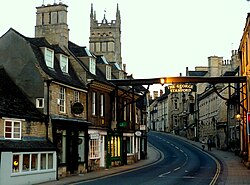 From Town Bridge towards St Martin's church. | |
| Location | |
| Grid reference: | TF025075 |
| Location: | 52°39’20"N, 0°29’1"W |
| Data | |
| Population: | 19,525 |
| Post town: | Stamford |
| Postcode: | PE9 |
| Dialling code: | 01780 |
| Local Government | |
| Council: | South Kesteven |
| Parliamentary constituency: |
Grantham and Stamford |
Stamford is a town in Kesteven in Lincolnshire, with a southern part extending into the Soke of Peterborough in Northamptonshire. It is in the very corner of Lincolnshire, edged by both Northamptonshire and Rutland. It stands on the Old North Road, now bypassed by the A1(M) to York and Edinburgh. The River Welland, the county boundary with Northamptonshire, runs at the bottom of a steep hill down which narrow lanes tumble to the meadows and the river is bridged here by a fine bridge of Barnack stone.
The town is best known for its mediæval core of streets, lined with 17th-18th century stone buildings, older timber framed buildings and five mediæval parish churches.[1]
The lie of the land
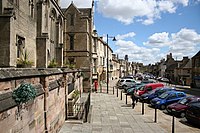
Stamford was declared a conservation area in 1967, the first urban conservation area. It has over 600 listed buildings, more than half of the total for the County of Lincoln. The town stands on the Lincolnshire bank of the River Welland but has streets extending up on the other side, and one of the town's most famous buildings, the George, stands on the other, the two parts of the town separated by the steep valley and meadows of the Welland. The conjoined parish of Wothorpe is in the Soke of Peterborough.
The river downstream of the town bridge, and some of the meadows fall within the drainage area of the Welland and Deepings Internal Drainage Board.[2]
History
Stamford was the first conservation area to be designated in England and Wales under the Civic Amenities Act 1967. Since then the whole of the old town and St Martins has been made an outstanding area of architectural or historic interest that is of national importance. Therefore, there is much interest in its vibrant local history.
In June 1968, a specimen of the sauropod dinosaur Cetiosaurus oxoniensis was found by Bill Boddington in the Williamson Cliffe quarry, close to Great Casterton. It was calculated to be around 170 million years old, from the Aalenian or Bajocian part of the Jurassic period.[3] The Rutland Dinosaur is one of the most complete dinosaur skeletons found in the United Kingdom, being 50 feet long, and since 1975 has been in the New Walk Museum in Leicester.
The Romans built Ermine Street, the great road from north to south, and its way reaches across Burghley Park and through the middle of the town. The original road forded the Welland, eventually reaching Lindum Colonia; the Romans too built a town to the north at Great Casterton. In AD 61, Boudica followed the Roman 9th Legion (Legio IX Hispana) across the river. Although the Romans made Great Casterton a bigger town, the English later chose Stamford as their main town, being on a more practical, navigable river than the River Gwash.
Stamford was one of the Danelaw's "Five Boroughs" and the only one not to become a county town. In 972 King Edgar made Stamford into a borough. The Anglo-Saxons and Danes faced each other across the river.[4] The town originally grew as a Danish settlement at the lowest point that the Welland could be crossed by ford or bridge.
Initially a pottery centre, producing Stamford Ware, by the Middle Ages it had become famous for its production of wool and the woollen cloth known as Stamford cloth. There is an example of this cloth, also called haberget, in Stamford Museum. Stamford was a walled town[4] but only a very small portion of the walls now remain. Stamford became an inland port on the Great North Road that superseded the Roman road Ermine Street, which passes near the town, where it forded the River Welland. Notable buildings in the town include the mediæval Browne's Hospital, several churches and the buildings of Stamford School, a public school founded in 1532.[4]
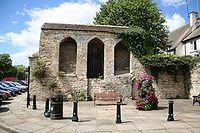
A Norman castle was built about 1075 by and apparently demolished in 1484.[4][5] The site stood derelict until the late twentieth century when it was built over and now includes a bus station and a modern housing development.
A small part of the curtain wall survives at the junction of Castle Dyke and Bath Row. From the doorway within it hustings were held until around 1971, the candidates speaking from a position above the crowd.
Stamford has been hosting an annual fair since the Middle Ages. Stamford Fair is mentioned in Shakespeare's Henry IV part 2 (act 3 scene 2). The mid-Lent fair is the largest street fair in Lincolnshire and one of the largest in the country. On 7 March 1190, crusaders at the fair led a pogrom; many Jews in the town were murdered.
In the great coaching days, Stamford was an important stop on the Great North Road. The George, the great inn on the south side of town, was a famous coaching inn. Many a romantic novel set in the eighteenth century has an elopement and a scene of confrontation at the George in Stamford.
Arms of the town
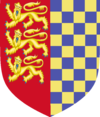
The arms of the town council are frequently met in the town and a source of civic pride. They are described as Per pale dexter side Gules three Lions passant guardant in pale Or and the sinister side chequy Or and Azure.[6] The three lions are the English royal arms, the blue and gold chequers are the arms of the de Warennes, who held the Manor in the 13th century.
Bull Running
For almost 700 years Stamford was host to a renowned bull-running festival on 13 November annually,[4] until it was abandoned in 1837 after a campaign by the Society for the Prevention of Cruelty to Animals.[7] Stamford residents defended their ancient custom as a "traditional, manly, English sport; inspiring courage, agility, and presence of mind under danger." Its defenders argued that it was less cruel and dangerous than fox hunting, and one local newspaper asked "Who or what is this London Society that, usurping the place of constituted authorities, presumes to interfere with our ancient amusement?"[7]
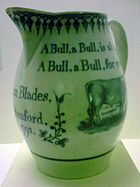
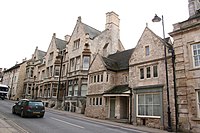
According to local tradition, the origin of the custom dated from the time of King John when, William de Warenne, 5th Earl of Surrey, standing on the battlements of the castle, saw two bulls fighting in the meadow beneath. Some butchers came to part the combatants and one of the bulls ran into the town, causing a great uproar. The earl, mounting his horse, rode after the animal, and enjoyed the sport so much, that he gave the meadow in which the fight began, to the butchers of Stamford, on condition that they should provide a bull, to be run in the town every 13 November, for ever after.[4] The town of Stamford acquired common rights in the meadow specified, a grassy flood plain next to the Welland, which until the last century was known as Bull-meadow, and today just as The Meadows - still a popular place of summer relaxation. In 1839, on one of the last bull runs, the bull was forced off the bridge into the river.
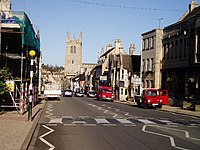
The last known witness of the final bull running was James Fuller Scholes who spoke of it in a newspaper interview in 1928 before his 94th birthday; "I am the only Stamford man living who can remember the bull-running in the streets of the town. I can remember my mother showing me the bull and the horses and men and dogs who chased it. She kept the St Peter's Street - the building that was formerly the Chequers Inn at that time and she showed me the bull-running sport from a bedroom window. I was only four years old then, but I can clearly remember it all. The end of St Peter's Street (where it was joined by Rutland Terrace) was blocked by two farm wagons, and I saw the bull come to the end of the street and return again. My mother told me not to put my head out of the window - apparently because she was afraid I should drop into the street."[8]
Seventeenth century historians described how the bull was chased and tormented for the day before being driven to the Bull-meadow and slaughtered and "Its flesh sold at a low rate to the people, who finished the day's amusement with a supper of bull-beef."[7]
Economy
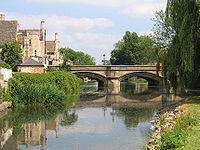
The town has a significant retail and retail service sector. The town centre is home to many independents and draws people from a wide area for the pleasure of shopping. There are numerous gift shops, homewares, men's and women's outfitters, shoe shops, and florists, as well as hair salons, beauty therapists, and eateries.
The town draws many visitors for its beauty, but it is a practical town too, the main town for the area, and the shops of the town cater for both.
National jeweller F Hinds can trace their history back to the clockmaker Joseph Hinds, who worked in Stamford in the first half of the nineteenth century and they also have a branch in the town.[9]
The surrounding villages and Rutland Water provide additional venues and employment opportunities, as do the several annual large events at Burghley House
South of the town is RAF Wittering, a main employer, and the Home of the Harrier. The airbase originally opened in 1916 as RFC Stamford, which closed then re-opened in 1924 under its present title.
A number of smaller firms — welders, printers and so forth — are either located in small collections of industrial units, or more traditional premises in older mixed-use parts of the town.
The Stamford Mercury claims to have been published since 1695, and to be "Britain's oldest newspaper".[10] The London Gazette also claims this honour, having been published since the 1660s; however, it is not now a newspaper in the usual sense.
Being in the midst of some of the richest farmland in England, and close to the famous "double cropping" land of parts of the fens, agriculture provides a small but steady number of jobs for the town, in farming, agricultural machinery, distribution and other ancillary services.
Landmarks
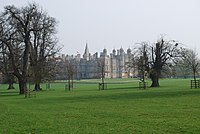
The Industrial Revolution largely left Stamford untouched. Much of town centre was built in the seventeenth and eighteenth centuries, in Georgian or Jacobean style.[4] Stamford is characterized by street after street of timber-framed and stone buildings (using the local limestone that Lincoln Cathedral is built from), little shops tucked down back alleys. The main shopping area was pedestrianized in the 1980s.
Near Stamford, across in the Soke of Peterborough and the parish of Barnack) is Burghley House, an Elizabethan mansion, vast and ornate, built by Sir William Cecil, later Lord Burghley, who served the Crown from the days of Henry VIII to the latter days of Queen Elizabeth I, and was Queen Elizabeth's closest adviser.[4] The house is the ancestral seat of Lord Burghley's successors, now with the title Marquess of Exeter. The tomb of William Cecil is in Saint Martins Church in Stamford. The parkland of the Burghley Estate adjoins the town of Stamford on two sides. Also inside the Soke is the nearby village of Wothorpe.
Another historic country house near Stamford, again outside the town and the county, is Tolethorpe Hall in Rutland, now host to outdoor theatre productions by the Stamford Shakespeare Company.[11]
Tobie Norris had a famous bell foundry in the town in the 17th century; his name is known more now as a local popular pub on St Pauls Street.[12]
Routes through and by the town
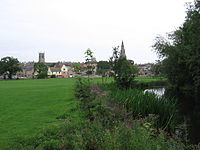
Lying as it does on the main north-south route, Stamford has been a stopping places across the ages Several Parliaments were held in Stamford in the Middle Ages. The George, the Bull and Swan, the Crown and the London Inn were well-known coaching inns. The town had to manage with Britain's north-south traffic through its narrow roads until 1960, when the bypass was built to the west of the town, only a few months after the M1 opened.[13] The old route is now the B1081. There is only one road bridge over the Welland (excluding the A1): a local bottleneck.
Foot bridges cross the Welland at the Meadows, some 500 yards upstream of the Town Bridge, and with the Albert Bridge a similar distance downstream. The town on both sides stands atop the bank, and footpaths run steeply down to the river and its meadows, on the side of the main town as lanes edges by houses clinging to the hill.
The Jurassic Way runs from Banbury to Stamford. The Hereward Way runs through the town from Rutland to the Peddars Way in Norfolk, along the Roman Ermine Street and then the River Nene. The Macmillan Way heads through the town, finishing at Boston and there is also the Torpel Way from the town to Peterborough, which follows the railway line, entering Peterborough at Bretton.
In former days, commercial boats used the Welland, and barges brought cargoes along a canal from Market Deeping to warehouses in Wharf Road until the 1850s,[4] when the canal was abandoned and now unusable. The shallowness of the river above Crowland prevents commerce o the river. There is a lock at the Sluice in Deeping St James but it is not in use. The river was not conventionally navigable upstream of the Town Bridge.
Churches
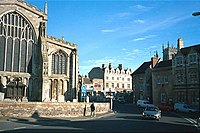
Stamford has several churches, including:
- Church of England:
- All Saints' Church
- Christ Church
- St George's Church
- St John the Baptist
- St Mary's
- St Martin's
- St Paul's Church in St Paul's Street is now a chapel for Stamford School
- Independent evangelical:
- Baptist:
- Stamford Free Church
- Strict Baptist Chapel
- Methodist: Trinity Methodist
- United Reformed Church
- Roman Catholic: St Mary and St Augustine Church
Filming location
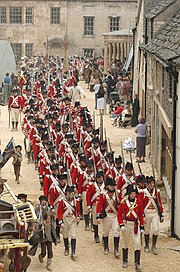
Stamford's ancient charm has made it a popular film location, often for period drama for which it may looks very much of the time, and indeed timeless. Some of the best knownproductions in which the town has been a star location are:
- Middlemarch (television)
- Pride & Prejudice' (2005) - used as the village of Meryton.
- The Da Vinci Code (2006)
- The Golden Bowl (2000)
Arts and entertainment
Stamford and nearby villages have their own substantial entertainment sector, as well as being able to access what is on offer in Peterborough, Leicester and other nearby cities. The local sector includes:
Organisations
- Stamford Shakespeare Company (nearby at Tolethorpe Hall)
- Stamford Pantomime Players
- Stamford Gilbert and Sullivan Players
- Stamford Brass (Stamford's Brass Band)
Venues
- Stamford Arts Centre
- Tolethorpe Hall
- The Corn Exchange
Festivals and events
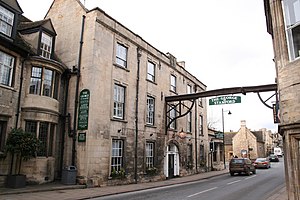
- Stamford Shakespeare Festival (held at Tolethorpe Hall nearby in Rutland)
- Burghley Horse Trials annually in early September
- Stamford Blues Festival
- Stamford Riverside Festival
- Stamford Mid Lent Fair
- Stamford Music Festival
References
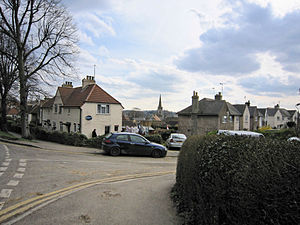
- ↑ "Stamford Conservation Area Draft Appraisal" South Kesteven Council conservation area appraisals.
- ↑ "Welland and Deepings IDB". http://www.wellandidb.org.uk/.
- ↑ "1968 Williamson Cliffe brick-pit, Rutland: Late/Upper Bajocian, United Kingdom". The Paleobiology Database. http://paleodb.org/cgi-bin/bridge.pl?action=displayCollectionDetails&collection_no=27876.
- ↑ 4.0 4.1 4.2 4.3 4.4 4.5 4.6 4.7 4.8 Samuel Lewis, ed (1848). A Topographical Dictionary of England. pp. 175–180 'St. Albans - Stamfordham'. http://www.british-history.ac.uk/report.aspx?compid=51295#s14.
- ↑ "National Monument Record for Stamford Castle". http://www.pastscape.org.uk/hob.aspx?hob_id=347832.
- ↑ Civic Heraldry
- ↑ 7.0 7.1 7.2 Chambers Book of Days (1864),. W. & R. Chambers ltd.. 1832. http://books.google.com/books?id=K0UJAAAAIAAJ. 13 November entry
- ↑ "Stamford & District News (Closed 1942),". http://www.netcomuk.co.uk/~dscholes/5034.html. Interview, 20 August 1928.
- ↑ "History of Hinds clockmakers". http://www.fhinds.co.uk/About_Us/Our_History.html.
- ↑ "The Rutland & Stamford Mercury". http://www.stamfordmercury.co.uk/newspaper.aspx.
- ↑ "Tolethorpe Hall". Stamford Shakespeare Company. http://www.stamfordshakespeare.co.uk/tolethorpe-hall.htm.
- ↑ Tobie Norris
- ↑ "Cinema Newsreel on opening of A1 Stamford Bypass by Minister of Transport Ernest Marples". http://www.britishpathe.com/record.php?id=41616.
| ("Wikimedia Commons" has material about Stamford) |
- William Page, ed (1906). A History of the County of Lincoln. Victoria County History. 2. pp. 234–235 'Hospitals: Stamford'. http://www.british-history.ac.uk/report.aspx?compid=38066&strquery=stamford#s2.
- William Page, ed (1906). A History of the County of Lincoln. Victoria County History. 2. pp. 225–230 'Friaries: Stamford'. http://www.british-history.ac.uk/report.aspx?compid=38052&strquery=stamford.
Outside links
- Stamford Town Council
- Stamford Civic Society
- Burghley House official site
- The Churches of Stamford
- Stamford Museum - a friendly local history museum for locals and visitors
- a good place to find statistics and research, including Stamford
- Stamford Living
- Visit Stamford
- Stamford - finest stone town in England
- Stamford Arts Centre
- Stamford Chamber of Commerce
- Stamford Roundtable District 611
- Stamford Transition Town
- Burghley House Heritage
- History of Blackstones
- Mirrlees Blackstone history
- Stamford historical summary (UK & Ireland Genealogy site)
- David Roffe's study - aspects of the Danelaw and Stamford
